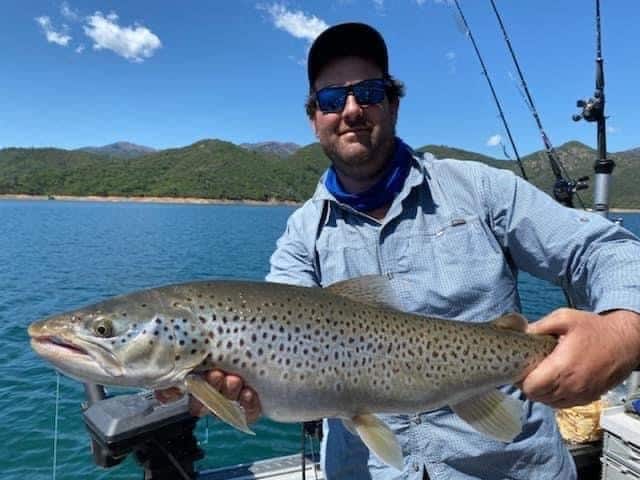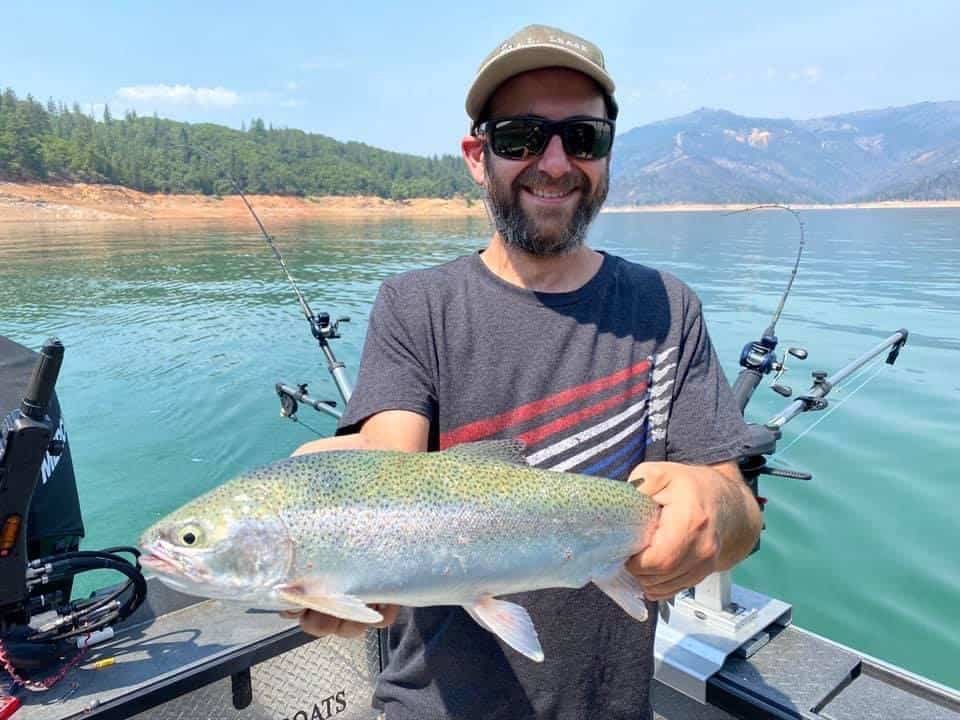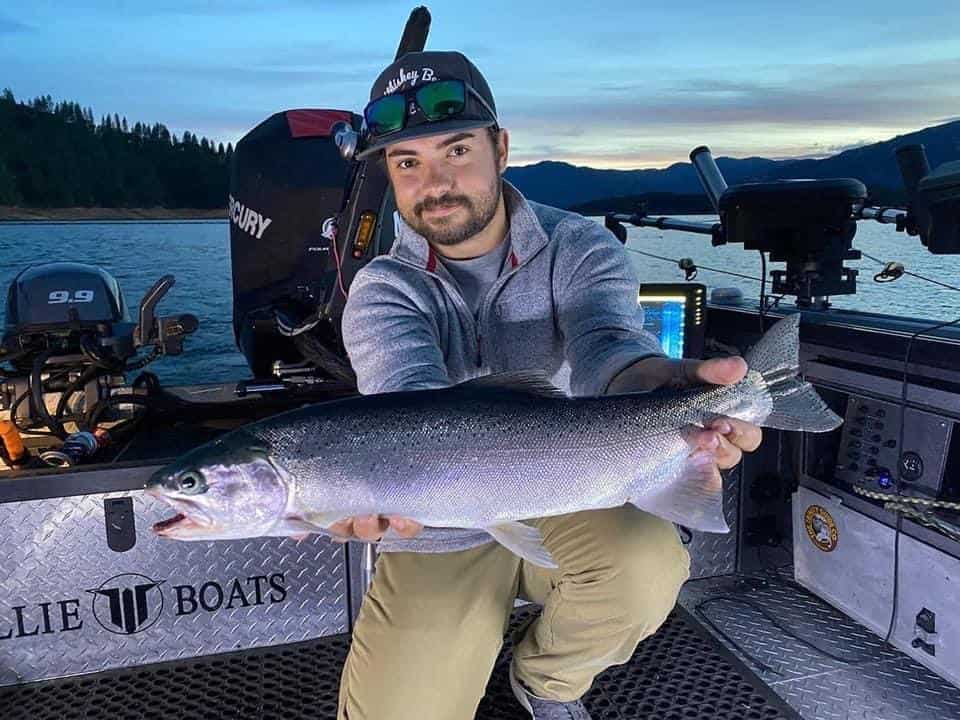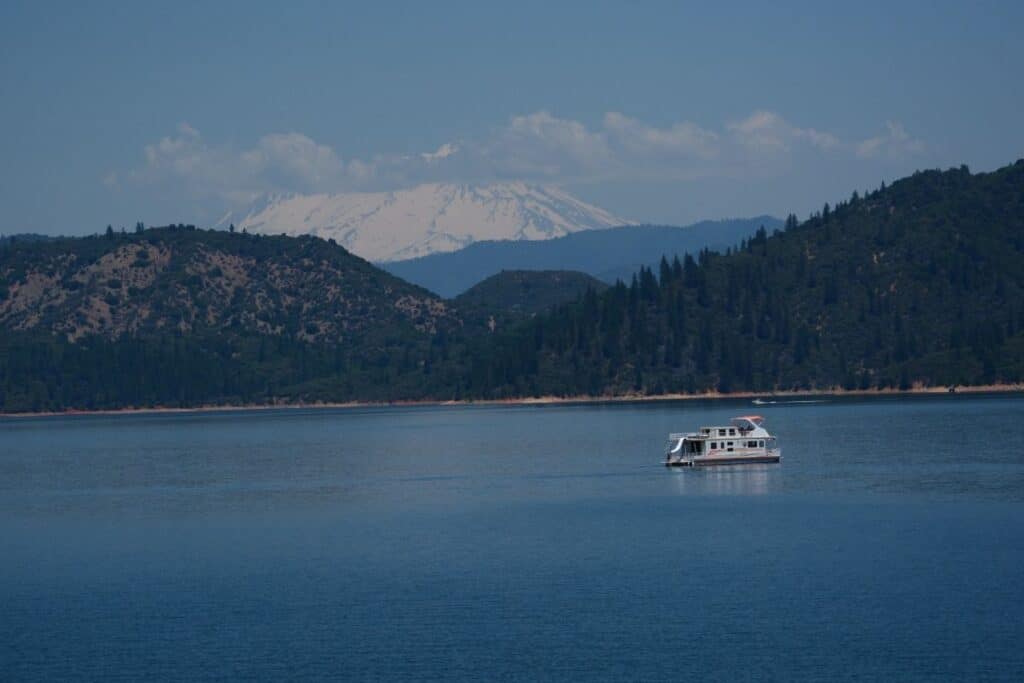Among California fishing lakes, Shasta Lake is the king. The undisputed heavyweight champ.
Spanning 30,000 acres with nearly 370 miles of shoreline, Shasta Lake is California’s largest man-made reservoir.
Also very commonly called Lake Shasta, it’s one of the state’s deepest lakes as well, with over 500 feet of water supporting a rich two-story fishery.
This Northern California reservoir is deep, cold and vast enough to allow excellent numbers of coldwater game fish like trout and salmon to thrive alongside warmwater species like bass and crappie.
It’s also a true year-round fishery. From the dog days of summer to the chilly winter months, there’s no season during which you can’t leave the water with a livewell full of fish.
For anglers, Shasta Lake offers endless possibilities.
But the lake’s enormous size can be a blessing as well as a curse. With four major arms and countless creek mouths, coves and points, the greatest challenge isn’t always catching fish. It’s finding them.
Created with the completion of the Shasta Dam in 1944, Shasta Lake is an impoundment of the Sacramento River, along with its tributaries the McCloud River, Pit River and Squaw Creek.
Each of these streams feeds one of Shasta’s four main arms. And arm each has the potential for a great day on the water.
Trout Fishing

There may be no better trout fishing lake on the West Coast than Shasta Lake. Rainbow trout and German brown trout have both been routinely stocked in Shasta Lake for decades.
And while rainbows are the more common species, helping land Shasta on our list of best rainbow trout lakes in California, anglers have great opportunities to catch both.
The lake harbors an incredible abundance of trout in the 3- to 5-pound class, and there are, without a doubt, some 10-pounders out there.
Fishing for rainbows is excellent throughout the Sacramento River Arm, as well as Dry Fork, Little Squaw Creek and Big Backbone Creek.
Those in search of big browns typically fare best in the McCloud River Arm, especially in the area between Turntable Bay and Hirz Bay.
The number of lunkers in the McCloud Arm help place Shasta among California’s best brown trout lakes.
Many consider late winter, just before the lake temperatures begin to warm, the best time for trout fishing on Shasta Lake.
Both brown and rainbow trout hunt in shallow water at this time, putting them within reach of shore anglers.
Casting with spinners and spoons is effective when trout are in Shasta’s shallows. Tipping the hook of one’s lure with a kernel of corn or a salmon egg is a favorite tactic.

The lake temperature tends to hover in the low 50s throughout winter. But once it starts to warm up, usually in March, rainbow trout begin making their way into Shasta Lake’s tributaries to spawn.
They return later in the spring, depleted and very hungry. Trout feed voraciously on shad and other baitfish as they return from the spawn, and eventually make their way toward deep water in the main lake.
They spend the warm summer months in these cool, deep waters where they feel most comfortable.
Trolling in the main lake, especially near the dam where the water is deepest, is the go-to tactic in summer.
Finding fish can be challenging with so much water to cover, but once you find them the action can be relentless.
Worth noting is that while rainbow trout are spring spawners, brown trout spawn in fall.
There are great opportunities to hook up with Shasta’s biggest brown trout as they make their way into shallow water in October, especially in the McCloud Arm.
For more ideas of how to catch trout at Shasta and anywhere else, check out our simple guide to trout fishing techniques.
Salmon Fishing
Chinook Salmon
King salmon are arguably the most sought-after fish in Shasta Lake.
Stocked as fingerlings, these Chinook salmon can top out at 10 pounds or more, and are some of the fiercest fighters in fresh water.
Although populations have fluctuated over the years, Shasta Lake has a reputation as one of the West Coast’s premier producers of giant landlocked king salmon.
These silver-sided giants follow seasonal patterns not unlike those of rainbow trout. The easiest time to find them in the relative shallows of the lake’s river arms is early spring, just as the lake is beginning to warm up.
They make their way deeper by mid-spring, driven by their preference for cooler water.
The top tactic for fishing kings is trolling along the shoreline during the early morning hours. Alex Ross of The Trinity Guide said his top lures are hoochies or Apex lures fished behind a large flasher.
Mooching isn’t as popular as in the old days, now that anglers are no longer able to fish close to the dam, Ross said.
Marshmallows, eggs, and combinations of the two can tempt spring kings as well. But by the time the heat of summer rolls around, salmon will have retreated to the depths of the main lake.
The tried-and-true tactic for catching these fish during the dog days of summer is trolling with large spoons in open water, especially near the dam.
A secret to success is often trailing a spoon behind a dodger, which creates extra flash and attraction.
In theory, the dodger creates the illusion of a school of shad or other baitfish, while the spoon trailing behind it looks like a weak member of the school lagging behind. In other words, it looks like easy prey to a hungry king.
Depth is crucial when you’re trolling for salmon. The best way to find fish is to experiment with varying depths while you keep an eye on your electronics.
At times, Chinook may hold 100 feet or more below the surface, so a downrigger is not just a convenience but at times is a necessity for trolling for salmon here.
Kings also rise closer to the surface at times too, following schools of shad that have greater tolerance for warm water.
While trolling, it’s not uncommon to find groups of salmon and trout in the same area, following the same schools of baitfish.
Read up on more salmon fishing techniques and tips.
Kokanee Fishing
Recently, the Department of Fish and Wildlife also has experimented a bit with stocking Shasta Lake with young kokanee.
These landlocked sockeye salmon are hugely popular in other deep, cold kokanee fishing lakes across California, and anglers were hoping Shasta joined them as the next big kokanee king.
While early indications were promising, kokanee have all but disappeared from most catches, Ross said on our last check.
If you do find yourself heading to Shasta and curious about kokanee, take a read through our article about simple kokanee fishing techniques and tips.
Bass Fishing
Few lakes in Northern California can match Shasta Lake when it comes to bass fishing.
With thriving populations of largemouth, smallmouth and spotted bass, it’s entirely possible to catch all three in a single fishing trip.
The best time to hit that triple would probably be May or October, but you have a solid chance of catching one species or another any time of year.
Smallmouth Bass
Shasta Lake routinely ranks among California’s best smallmouth bass fisheries.
Overall, smallies are somewhat rare in the state, but Shasta Lake is one of a handful of Northern California reservoirs where they thrive.
A few key features make that possible; namely Shasta has deep, clear water with lots of rocky cover, and prime spawning habitat.
Smallmouths head toward shallow water to spawn every year as winter turns to spring, and the months of March through May are arguably the best time to be on the water.
Fishing along rocky points and gravelly shorelines is often productive.
Crawfish, as well as shad and minnows, provide major food sources for smallmouths on Shasta Lake, so you can have success throwing a wide variety of lures.
Jigs and soft plastics fished near the bottom in rocky cover are often the best choice.
At times, though, you can have better luck casting spinnerbaits and crankbaits across rocky points. Be ready to try a few different tactics, and let the bass tell you what they want.
There are some good-sized smallmouths in Shasta Lake, where 2- and 3-pounders are fairly common, and a 5-pound brute turns up every now and again.
Spotted Bass
Spotted bass are the most common bass species in Shasta Lake. Although they weren’t introduced until as recently as the 1970s, “spots,” as they are often known, have come to thrive here.
Some anglers might debate as to whether spotted bass were a welcome addition to the lake.
No matter your position on that, there’s one hard-to-overlook benefit: Spots are active in colder conditions than either smallmouth or largemouth bass.
So when the bass fishing slows down in winter, spotted bass are here to keep fishermen busy.
Late winter and early spring are prime time to be out on the lake chasing spots.
All four river arms can be productive, and spotted bass frequently gravitate toward rocky drop-offs, points and any area that has either brush piles or woody cover.
Standing timber in the Pitt River and Squaw Creek arms offers particularly good fishing for spotted bass. Wacky worms, spider grubs and finesse worms on drop-shot rigs are all great lure choices.
Spotted bass are also a bit more inclined to suspend in open water than smallmouth or largemouth bass. This is especially the case in summer, when they often chase open-water schools of baitfish.
Fishing for spotted bass on Shasta Lake isn’t so much about size—it’s more of a numbers game—but there are plenty of 1- and 2-pounders out there.
We also have an article that will show you all of California’s best spotted bass lakes.
Largemouth Bass
Largemouths seem to get a bit less attention at Shasta Lake, perhaps because overall, they’re so much more common statewide than spotted bass and especially smallmouths.
But one of the great things about fishing at Shasta Lake is that it’s a rare spot where you’re likely to catch a “grand slam” of all three species in a single day. And of the three, the biggest will likely be a largemouth.
It’s entirely possible to target 10-pound-plus largemouths at Shasta Lake, which is why we gave it honorable mention status in our run-down of Best Largemouth Bass Lakes in Northern California.
These fish grow fat on the yearling trout stocked by the California Department of Fish and Game, and if you’re out after big bass, trout-patterned swimbaits are the lure of choice.
Wacky worms, spinnerbaits and creature baits are all effective too.
The prime window for catching largemouth bass is early to mid-summer, as they tend to thrive in warmer water better than smallmouths or spotted bass.
They love aquatic vegetation too, and the best areas tend to be coves and the mouths of creeks around weed beds, brush piles and fallen timber.
Work your lure along the edges of weeds and brushy cover, especially in areas where a sharp drop provides access to both deep and shallow water.
Sloping rocky points near weedy shallow haunts can also be great places to look for big bass.
How to Catch Bass
We can hook you up with even more great bass fishing tips in our simple guide.
Crappie Fishing
Prospects for crappie fishing on Shasta Lake seem to ebb and flow, following a “boom or bust” cycle also common at many other lakes.
Some years, you can’t catch them fast enough. Other times, they seem to disappear completely.
But when the bite is on, crappie provide great fun and great eating.
During those years, Shasta ranks right up there among the best crappie fishing lakes in California.
Crappies often hang out amongst weed beds, brush piles and under docks, and bite readily on small jigs and live minnows.
Evening hours are often the best time to catch them, when they emerge from the deep cover they shelter in during the day.
Crappies are often drawn to lighted docks at night, following schools of minnows that eat the phytoplankton that are drawn to the lights.
Crappies are usually in the 9- to 12-inch range on Shasta Lake, but they’re fun fighters for their size and occasionally weigh a pound or more.
If you catch wind of a strong class of these fish at Shasta or elsewhere, you’ll want to up your game with our crappie fishing techniques and tips.
Catfish Fishing
Catfish offer a great under-the-radar opportunity on Shasta Lake.
Ignored by most fishermen, channel catfish are some of the biggest and hardest-fighting fish the lake has to offer. They are also great-eating fish with mild white flesh.
You can catch catfish any time of year at Shasta Lake, but late spring through summer is ideal.
Fishing after sunset is permitted, and a strong case could be made that the best bite for big cats is after dark, when they leave their deep haunts and prowl shallow flats in search of food.
Smelly, natural baits fished near the bottom are the best way to tempt catfish. Local anglers tend to favor anchovies, cut shad, chicken livers, and various homemade or store-bought stink baits.
Channel catfish are common, and there are plenty of 10-plus pound channel cats in Shasta Lake. If you’re out looking to fish for the table, 2- to 4-pounders are generally considered to taste better.
Shasta Lake also has a population of sturgeon, ancient giants that can weigh over 100 pounds, and are occasionally caught by catfish anglers. Best keep a tight grip on your rod!
Find more catfish fishing tips here.
Also, if you’re looking for even more of these fish, we highly suggest a read through our Best Catfish Fishing Lakes and Rivers in California.
Planning Your Trip
Surrounded by rugged, densely wooded slopes and offering a picturesque view of Mt. Shasta in the distance, Shasta Lake is one of Northern California’s most beautiful lakes, as well as one of the best fishing destinations.
The lake offers an abundance of marinas, public launch ramps and shore fishing access sites. One factor anglers should be aware of is that fluctuating water levels throughout the year can affect lake access.
Where is Shasta Lake?
Shasta Lake is located near the southern end of Shasta-Trinity National Forest, and just a few miles north of the town of Shasta Lake.
From Redding—the nearest major city—it’s about a 20-minute drive to the closest lake access.
The quickest route to the Shasta Dam from Redding is via County Highway A-18. More northerly points on the lake are easily accessible just off Interstate 5.
Boat Access
Several public launch ramps are located around the Shasta Lake shoreline, providing boat access to all parts of the lake. They are operated by the Shasta Recreation Company, which charges a small fee to park and launch at each site.
The public ramps are open year-round, but some may occasionally close when lake drawdowns or hazardous conditions make them unsafe or impossible to use, or when parking lots fill up.
The Centimudi Bay, Jones Valley and Bailey Cove ramps are generally the most popular, and it’s common for the parking lots to fill up on a holiday weekend. Centimudi and Jones Bar are also the least likely to close completely due to low water.
You can also choose to launch at any of the privately owned marinas around Shasta Lake. Digger Bay Marina is nearest to the dam and just a few minutes from the Centimudi Bay launch site.
Other options include Holiday Harbor on the McCloud River Arm, Jones Valley Resort on the Pit Arm, and Sugarloaf Resort on the Sacramento River Arm.
Shore Fishing
One of Shasta Lake’s many charms is that it offers an abundance of shore fishing access.
At times, such as when trout hunt close to the bank in early spring, dry land may well be the best place to be.
The area around the Shasta Dam is popular among shore anglers. Hiking trails lead to either side of the dam: Take the Dry Fork Creek trail to the northwest of the dam and the Fisherman’s Point Trail to the southeast.
Fishing under the Pit River Bridge is also popular, and many of the lake’s public launch sites, including the Packers Bay and Bailey Cove boat ramps, have nearby trails leading to more secluded shore access sites.
All told, there are dozens of places where one can reach the shore and access prime fishing water, including most of the campgrounds that surround Shasta Lake.
In many places, simply driving along the shore will reveal excellent fishing sites.
Lakeshore Drive runs parallel to the Sacramento River Arm, and Gilman Road follows the McCloud Arm, both offering abundant opportunities to hop out and test the waters.
Camping & Accommodations
As part of Shasta-Trinity National Forest, more than 20 campgrounds offer sites on or near the shore of Shasta Lake.
Spots to consider range from primitive shoreline campgrounds like the Beehive and Gregory Beach Campgrounds to more developed facilities at the Bailey Cove, Lakeshore East and Antlers campgrounds.
All told, these campgrounds offer hundreds of campsites for both tents and RVs.
There are also a handful of remote boat-in campgrounds, including the Ski Island and Gooseneck Cove campgrounds, which provide a bare minimum of amenities and are accessible only from the water.
Many of the marinas and resorts surrounding the lake also offer cabins, cottages and vacation rentals.
Acknowledgment
Thanks to Alex Ross of The Trinity Guide Co. for helping us make this article as accurate and helpful as possible.


